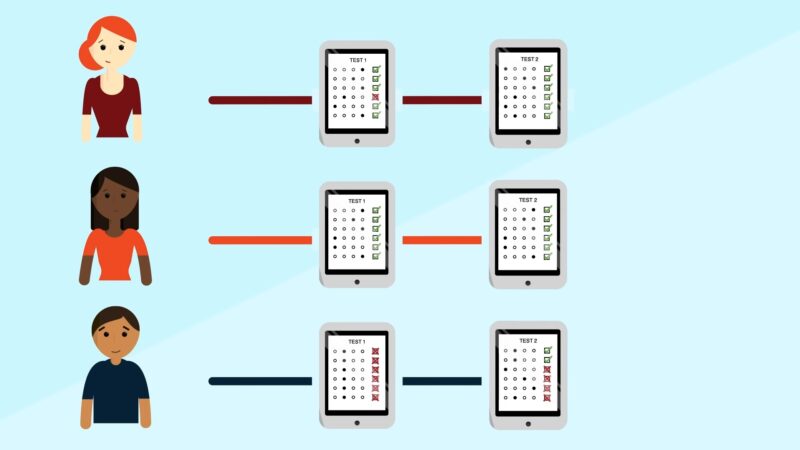Diagnostic assessments serve as tools to gauge students’ existing knowledge, skills, and competencies ahead of introducing new subjects or units. These evaluations pinpoint learners’ areas of strength and areas needing improvement, alongside identifying any learning gaps or misconceptions.
Such tests enable educators to devise tailored and impactful teaching strategies, permitting adjustments to the curriculum that align with the unique needs and interests of their pupils.
Key Takeaways
- Personalized Learning: Diagnostic tests enable educators to tailor instruction to individual students’ needs and interests, facilitating targeted feedback and customized learning experiences that address specific knowledge gaps and learning objectives.
- Enhanced Teaching Effectiveness: These assessments guide teachers in focusing on essential content and skills, minimizing unnecessary repetition, and optimizing instructional time. Diagnostic tests also allow for the evaluation and adjustment of teaching methods to improve student learning outcomes.
- Supportive Learning Environment: By starting instruction from students’ current understanding, diagnostic tests promote a positive and efficient learning atmosphere. They encourage self-awareness, goal-setting, and motivation by making learning relevant and rewarding.
- Diverse Assessment Types and Tools: Diagnostic tests range from standardized to informal, employing a variety of tools such as Likert-scale surveys, concept maps, discussion boards, and entry slips. This diversity enables assessments to be tailored to specific learning contexts, subjects, and objectives, although each type has its advantages and limitations in terms of validity, reliability, and alignment with curricular goals.
Why Do We Use Them?

Diagnostic tests are an essential component of modern education, serving as a bridge between students’ existing knowledge and the learning objectives of a new topic or unit. These assessments are not merely tools for measurement; they are foundational to creating a dynamic and responsive educational environment.
The rationale behind their usage spans across multiple dimensions of the teaching and learning process, making them invaluable for both teachers and students alike.
Personalized learning
Diagnostic tests empower educators to customize their teaching methodologies to cater to the unique requirements and aspirations of individual students.
Armed with insights into students’ existing knowledge and learning gaps, instructors can craft instruction that is pertinent, stimulating, and appropriately challenging for each learner.
Furthermore, teachers can furnish targeted feedback and assistance to students based on the findings of diagnostic assessments.
Improved teaching effectiveness
By leveraging diagnostic tests, educators can hone in on the core content and competencies crucial for their students’ progress. This targeted approach allows them to circumvent unnecessary repetition and ensure comprehensive coverage of essential concepts, optimizing the utilization of instructional time and resources.
Diagnostic assessments serve as a valuable tool for educators to evaluate the effectiveness of their pedagogical approaches, facilitating adjustments as warranted.
Efficient and fulfilling learning environment
Diagnostic tests foster a conducive and rewarding learning atmosphere for students. Beginning instruction from their current level of comprehension enables learners to build upon existing knowledge, fostering a sense of accomplishment and competence as they progress in their learning journey.
They prompt students to cultivate self-awareness and metacognitive skills as they reflect on their learning and set objectives for improvement. Such assessments also bolster students’ motivation and engagement by highlighting the relevance and significance of their educational pursuits.
What Types of Tests Exist?
Diagnostic tests can be classified into two main types: standardized and informal.
Standardized diagnostic tests
These assessments are formal evaluations characterized by predefined and consistent methodologies and criteria for measuring students’ knowledge and skills. Typically administered by external entities or organizations, standardized tests adhere to a predetermined format and structure.
Standardized diagnostic tests offer an objective and dependable means of comparing students’ performance across diverse groups, schools, or regions. Nonetheless, they may lack alignment with specific curricula or learning objectives tailored by educators or institutions.
Their administration and scoring processes can incur considerable costs and time investments.
Informal diagnostic tests
Conversely, informal diagnostic tests encompass flexible and adaptable assessments employing diverse tools and methodologies to assess students’ prior knowledge and skills. Typically devised and administered by educators or even the students themselves, these tests can be tailored to fit the context and objectives of the learning environment.
Informal diagnostic tests furnish a more authentic and pertinent approach to evaluating students’ learning, as they mirror the actual content and activities undertaken in the classroom. However, they may exhibit lesser validity and reliability compared to standardized counterparts, often susceptible to subjective influences such as teacher bias or student disposition.
What Are the Common Tools?

Diagnostic tests use various tools tailored to the assessment’s type, subject, and level. Common tools include:
- Likert-scale surveys: These prompt students to rate agreement or disagreement on a scale from 1 to 5, assessing attitudes, beliefs, or self-efficacy. For example, they can measure confidence in algebra or interest in ancient civilizations.
- Concept maps: Graphical representations show relationships between concepts, measuring comprehension and connections. For instance, they can illustrate photosynthesis stages or French Revolution causes and effects.
- Discussion boards: Online platforms where students post and respond to topics, assessing prior knowledge and communication skills. Teachers may use them for exploring climate change understanding or debates on genetic engineering.
- Entry slips: Brief written responses at lesson start, gauging prior knowledge or questions. For example, they may prompt students to list fractions knowledge or express curiosity about the solar system.
What Are Some Examples?
Diagnostic tests can be applied in various disciplines and at different educational levels. Here are some examples of diagnostic tests for different subjects.
Psychology
In psychology, a teacher might utilize a concept map to prompt students to visually depict Piaget’s stages of cognitive development and their interrelation with different aspects of human behavior and learning.
This exercise aids the teacher in identifying students’ existing knowledge and misconceptions regarding the topic, facilitating tailored instruction.
English
In an English class, a teacher could employ a Likert-scale survey to gauge students’ familiarity and interest levels concerning various Shakespearean plays and themes, such as Romeo and Juliet, Macbeth, or Hamlet.
This survey assists the teacher in selecting texts and activities that resonate most with students, while also addressing any knowledge gaps or difficulties they may encounter.
Chemistry
For chemistry students, a teacher might utilize a simple checklist requiring students to outline the steps involved in conducting a laboratory experiment, including measuring, mixing, heating, and observation. This checklist enables the teacher to evaluate students’ procedural knowledge and skills, offering guidance and feedback as necessary to enhance their understanding.
Law

FAQ
How do diagnostic tests differ from other forms of assessments like quizzes and final exams?
Unlike quizzes and final exams that assess students’ learning at the end or throughout a course to grade their performance, diagnostic tests are used before a course or unit begins. Their purpose is not to grade but to understand students’ existing knowledge and skills, allowing for instruction to be tailored to their needs.
Can diagnostic tests be used in all grade levels and subjects?
Yes, diagnostic tests are versatile and can be adapted for use across all grade levels and subjects. They are designed to measure prior knowledge and skills relevant to the specific content and objectives of any new topic or unit, regardless of the academic discipline.
How often should diagnostic tests be administered in an educational setting?
Diagnostic tests are typically administered at the beginning of a new unit or course. However, they can also be used periodically throughout the academic year to assess understanding of subsequent topics or to adjust teaching strategies based on students’ evolving needs and knowledge gaps.
What role do diagnostic tests play in differentiated instruction?
Diagnostic tests are crucial for differentiated instruction as they provide the necessary data to identify each student’s learning level and style. This information enables educators to design varied teaching methods and materials that cater to the diverse needs of their students, ensuring a more inclusive and effective learning environment.
How can educators ensure the reliability and validity of informal diagnostic tests?
Educators can enhance the reliability and validity of informal diagnostic tests by ensuring that they are well-designed and directly aligned with the learning objectives. This involves clear, objective criteria for assessment, consistent administration, and regular review and adjustment based on feedback and outcomes.
In what ways can students participate in the diagnostic testing process?
Students can participate in the diagnostic testing process by engaging in self-assessment activities, contributing to the development of test questions based on their prior knowledge, and reflecting on their test results to set personal learning goals. This active involvement can increase their awareness of their own learning needs and motivate them to take charge of their educational journey.
Bottom Line
Diagnostic tests are a valuable tool for teachers and students to enhance the quality and effectiveness of teaching and learning. By assessing students’ prior knowledge and skills before starting a new topic or unit, diagnostic tests help teachers plan personalized and meaningful instruction, and improve their teaching strategies and outcomes.
